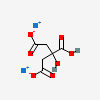Disodium Hydrogen Citrate
- Disodium citrate
- Alkacitron
- Citralka
- Sodium acid citrate
- Sodium citrate, acid
- Create:2005-08-08
- Modify:2025-01-18

- Disodium citrate
- Alkacitron
- Citralka
- Sodium acid citrate
- Sodium citrate, acid
- Natrium citricum
- Natrium citricum [German]
- Citric acid, disodium salt
- DISODIUM HYDROGEN CITRATE
- Disodium monohydrogen citrate
- HSDB 375
- Citric acid disodium salt
- UNII-6FO62KCQ7A
- EINECS 205-623-3
- Disodium 2-hydroxy-1,2,3-propanetricarboxylate
- 6FO62KCQ7A
- DTXSID50889423
- Disodium citrate sesquihydrate
- NATRIUM CITRICUM (GERMAN)
- SODIUM CITRATE ACID
- ANHYDROUS DISODIUM CITRATE
- SODIUM ACID CITRATE (MART.)
- SODIUM ACID CITRATE [MART.]
- SODIUM CITRATE ACID [WHO-DD]
- CITRIC ACID DISODIUM SALT [MI]
- DISODIUM HYDROGEN CITRATE [HSDB]
- 6132-05-4
- Dibasic sodium citrate
- DTXCID901326763
- Disodium 2hydroxy1,2,3propanetricarboxylate
- 1,2,3Propanetricarboxylic acid, 2hydroxy, disodium salt
- 1,2,3Propanetricarboxylic acid, 2hydroxy, sodium salt (1:2)
Information on 2 consumer products that contain Disodium hydrogen citrate in the following categories is provided:
• Inside the Home
Information on 1 consumer products that contain Disodium citrate sesquihydrate in the following categories is provided:
• Inside the Home
2019: 6,388 lb
2018: 33,573 lb
2017: 33,674 lb
2016: 18,532 lb
Not Classified
Reported as not meeting GHS hazard criteria by 99 of 99 companies. For more detailed information, please visit ECHA C&L website.
Aggregated GHS information provided per 99 reports by companies from 1 notifications to the ECHA C&L Inventory.
Reported as not meeting GHS hazard criteria per 99 of 99 reports by companies. For more detailed information, please visit ECHA C&L website.
There are 0 notifications provided by 0 of 99 reports by companies with hazard statement code(s).
Information may vary between notifications depending on impurities, additives, and other factors. The percentage value in parenthesis indicates the notified classification ratio from companies that provide hazard codes. Only hazard codes with percentage values above 10% are shown.
Patents are available for this chemical structure:
https://patentscope.wipo.int/search/en/result.jsf?inchikey=CEYULKASIQJZGP-UHFFFAOYSA-L
- Australian Industrial Chemicals Introduction Scheme (AICIS)1,2,3-Propanetricarboxylic acid, 2-hydroxy-, disodium salthttps://services.industrialchemicals.gov.au/search-assessments/1,2,3-Propanetricarboxylic acid, 2-hydroxy-, disodium salthttps://services.industrialchemicals.gov.au/search-inventory/
- ChemIDplusDisodium hydrogen citratehttps://pubchem.ncbi.nlm.nih.gov/substance/?source=chemidplus&sourceid=0000144332ChemIDplus Chemical Information Classificationhttps://pubchem.ncbi.nlm.nih.gov/source/ChemIDplus
- EPA Chemical Data Reporting (CDR)LICENSEThe U.S. Government retains a nonexclusive, royalty-free license to publish or reproduce these documents, or allow others to do so, for U.S. Government purposes. These documents may be freely distributed and used for non-commercial, scientific and educational purposes.https://www.epa.gov/web-policies-and-procedures/epa-disclaimers#copyright1,2,3-Propanetricarboxylic acid, 2-hydroxy-, sodium salt (1:2)https://www.epa.gov/chemical-data-reporting
- EPA Chemicals under the TSCA1,2,3-Propanetricarboxylic acid, 2-hydroxy-, sodium salt (1:2)https://www.epa.gov/chemicals-under-tsca
- EPA DSSToxDisodium hydrogen citratehttps://comptox.epa.gov/dashboard/DTXSID50889423CompTox Chemicals Dashboard Chemical Listshttps://comptox.epa.gov/dashboard/chemical-lists/
- European Chemicals Agency (ECHA)LICENSEUse of the information, documents and data from the ECHA website is subject to the terms and conditions of this Legal Notice, and subject to other binding limitations provided for under applicable law, the information, documents and data made available on the ECHA website may be reproduced, distributed and/or used, totally or in part, for non-commercial purposes provided that ECHA is acknowledged as the source: "Source: European Chemicals Agency, http://echa.europa.eu/". Such acknowledgement must be included in each copy of the material. ECHA permits and encourages organisations and individuals to create links to the ECHA website under the following cumulative conditions: Links can only be made to webpages that provide a link to the Legal Notice page.https://echa.europa.eu/web/guest/legal-noticeDisodium hydrogen citratehttps://chem.echa.europa.eu/100.005.1131,2,3-Propanetricarboxylic acid, 2-hydroxy-, sodium salt, hydrate (2:4:3)https://echa.europa.eu/substance-information/-/substanceinfo/100.110.966Disodium hydrogen citrate (EC: 205-623-3)https://echa.europa.eu/information-on-chemicals/cl-inventory-database/-/discli/details/224201,2,3-Propanetricarboxylic acid, 2-hydroxy-, sodium salt, hydrate (2:4:3) (EC: 612-119-0)https://echa.europa.eu/information-on-chemicals/cl-inventory-database/-/discli/details/23108
- Hazardous Substances Data Bank (HSDB)DISODIUM HYDROGEN CITRATEhttps://pubchem.ncbi.nlm.nih.gov/source/hsdb/375
- New Zealand Environmental Protection Authority (EPA)LICENSEThis work is licensed under the Creative Commons Attribution-ShareAlike 4.0 International licence.https://www.epa.govt.nz/about-this-site/general-copyright-statement/
- ClinicalTrials.govLICENSEThe ClinicalTrials.gov data carry an international copyright outside the United States and its Territories or Possessions. Some ClinicalTrials.gov data may be subject to the copyright of third parties; you should consult these entities for any additional terms of use.https://clinicaltrials.gov/ct2/about-site/terms-conditions#Use
- Consumer Product Information Database (CPID)LICENSECopyright (c) 2024 DeLima Associates. All rights reserved. Unless otherwise indicated, all materials from CPID are copyrighted by DeLima Associates. No part of these materials, either text or image may be used for any purpose other than for personal use. Therefore, reproduction, modification, storage in a retrieval system or retransmission, in any form or by any means, electronic, mechanical or otherwise, for reasons other than personal use, is strictly prohibited without prior written permission.https://www.whatsinproducts.com/contents/view/1/6Disodium hydrogen citratehttps://www.whatsinproducts.com/chemicals/view/1/4883/000144-33-2Disodium citrate sesquihydratehttps://www.whatsinproducts.com/chemicals/view/1/6523/006132-05-4Consumer Products Category Classificationhttps://www.whatsinproducts.com/
- EPA Chemical and Products Database (CPDat)Disodium hydrogen citratehttps://comptox.epa.gov/dashboard/DTXSID50889423#exposureEPA CPDat Classificationhttps://www.epa.gov/chemical-research/chemical-and-products-database-cpdat
- Haz-Map, Information on Hazardous Chemicals and Occupational DiseasesLICENSECopyright (c) 2022 Haz-Map(R). All rights reserved. Unless otherwise indicated, all materials from Haz-Map are copyrighted by Haz-Map(R). No part of these materials, either text or image may be used for any purpose other than for personal use. Therefore, reproduction, modification, storage in a retrieval system or retransmission, in any form or by any means, electronic, mechanical or otherwise, for reasons other than personal use, is strictly prohibited without prior written permission.https://haz-map.com/AboutDisodium hydrogen citratehttps://haz-map.com/Agents/13831
- EU Food Improvement AgentsDISODIUM CITRATEhttp://data.europa.eu/eli/reg/2012/231/2024-04-23
- FDA Substances Added to FoodLICENSEUnless otherwise noted, the contents of the FDA website (www.fda.gov), both text and graphics, are not copyrighted. They are in the public domain and may be republished, reprinted and otherwise used freely by anyone without the need to obtain permission from FDA. Credit to the U.S. Food and Drug Administration as the source is appreciated but not required.https://www.fda.gov/about-fda/about-website/website-policies#linking
- Japan Chemical Substance Dictionary (Nikkaji)
- NCI Thesaurus (NCIt)LICENSEUnless otherwise indicated, all text within NCI products is free of copyright and may be reused without our permission. Credit the National Cancer Institute as the source.https://www.cancer.gov/policies/copyright-reuseNCI Thesaurushttps://ncit.nci.nih.gov
- NLM RxNorm TerminologyLICENSEThe RxNorm Terminology is created by the National Library of Medicine (NLM) and is in the public domain and may be republished, reprinted and otherwise used freely by anyone without the need to obtain permission from NLM. Credit to the U.S. National Library of Medicine as the source is appreciated but not required. The full RxNorm dataset requires a free license.https://www.nlm.nih.gov/research/umls/rxnorm/docs/termsofservice.htmldisodium hydrogen citratehttps://rxnav.nlm.nih.gov/id/rxnorm/1366889disodium citrate sesquihydratehttps://rxnav.nlm.nih.gov/id/rxnorm/2049608
- SpectraBaseCITRIC ACID, DISODIUM SALThttps://spectrabase.com/spectrum/DCOqec0OENscitric acid, disodium salthttps://spectrabase.com/spectrum/5zcIBySb1FACITRIC ACID, DISODIUM SALThttps://spectrabase.com/spectrum/1oIt5wzmeWN
- Springer Nature
- Wikidatadisodium citratehttps://www.wikidata.org/wiki/Q4177124
- Wikipediadisodium citratehttps://en.wikipedia.org/wiki/Disodium_citrate
- PubChem
- GHS Classification (UNECE)GHS Classification Treehttp://www.unece.org/trans/danger/publi/ghs/ghs_welcome_e.html
- MolGenieMolGenie Organic Chemistry Ontologyhttps://github.com/MolGenie/ontology/
- PATENTSCOPE (WIPO)SID 403389684https://pubchem.ncbi.nlm.nih.gov/substance/403389684


 CID 311 (Citric Acid)
CID 311 (Citric Acid) CID 5360545 (Sodium)
CID 5360545 (Sodium)